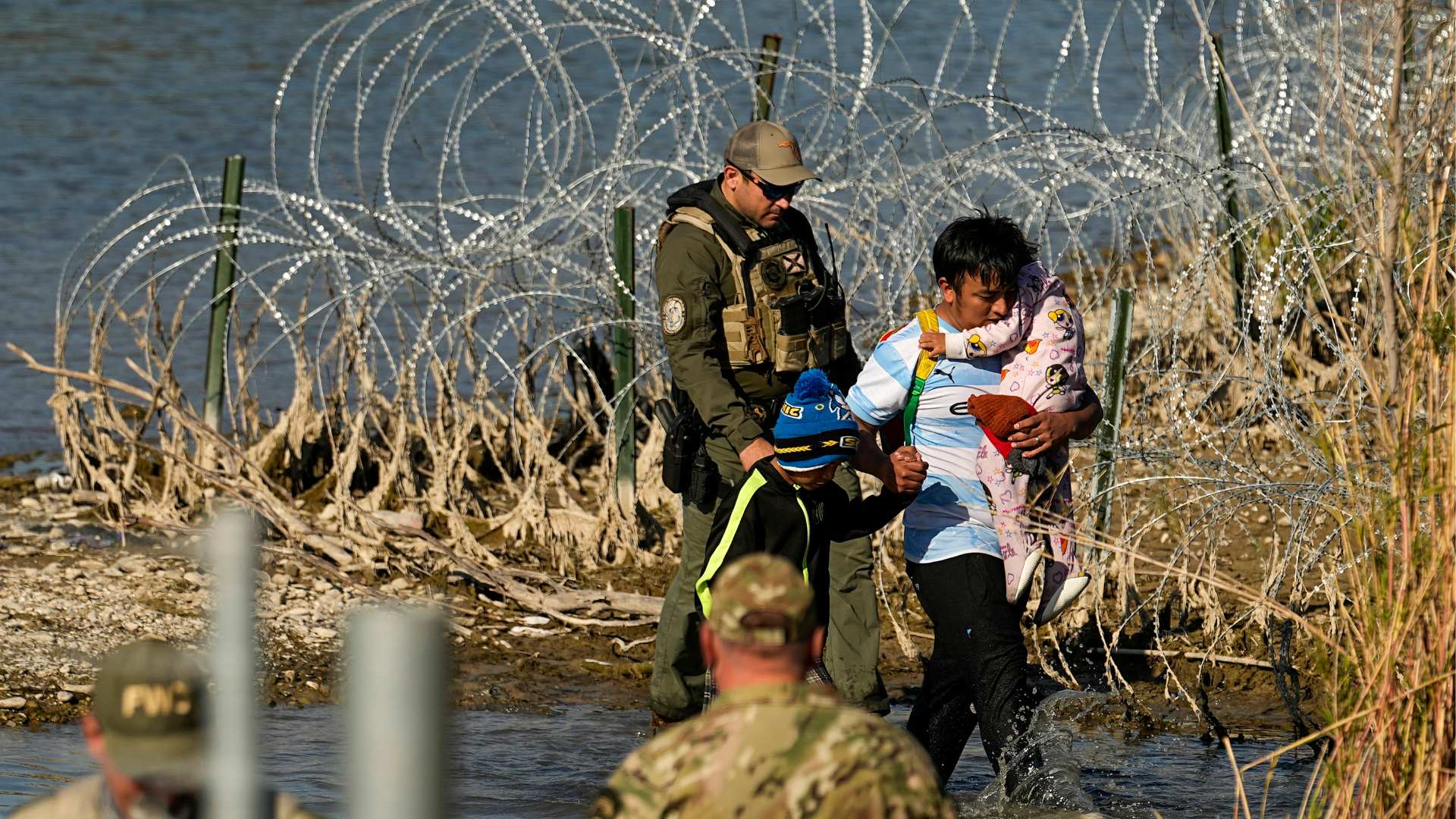Millions of migrants cross the U.S.-Mexican border. North of the border, some fear them. But the economy depends on migrants and it is they who face real dangers.

A man carries a child as they are taken into custody by officials at the Texas-Mexico border in Eagle Pass, Texas, 3 January 2024. (AP Photo/Eric Gay)
Borderlands, in many cultures, can be places of transformation — and danger. You might find a new life. You might simply vanish. You might die. That’s rarely been truer than for people trying to reach and cross the U.S. border from the south right now.
South of the frontier, gangsters kidnap, extort and sometimes kill migrants seeking a new life in the United States. The hostile border terrain claims an untold number of victims every year. U.S. immigration authorities, though increasingly swamped, have hardened the southern border with high and low tech.
Yet people come, seeking a better life. They’re coming from ever farther afield, and in mounting numbers. The rigors of the journeys they undertake suggest they’re not, by and large, the kind of people who wilt at a challenge or lack initiative. Some are fleeing repression, violence and crime. Others seek greater economic opportunity than they would find at home. Few have an easy ride.
Just ask José Vargas, who made the trek from Ecuador’s biggest city, Guayaquil, to New York late last year, a distance of just about 3,000 miles (4,828 km). He is a former small-scale restaurateur who ran afoul of criminal gangs demanding “vacuna” (protection money, literally “a vaccination”) in his hometown.
Vargas isn’t his real name. He spoke on condition that his real name not be used, in order to protect his family.
Seeking a safer life
Last year, Vargas and his wife sold everything they had to seek a better life in the United States for themselves and their three children, one of whom has cerebral palsy. They traveled together throughout.
Lacking U.S. visas, Vargas arranged for a series of “coyotes” or guides to smuggle his family from place to place, each privy to only part of their planned journey.
“We went up the mountain and down,” he said, describing the last stages of a journey of several weeks with his wife and children from Ecuador, via El Salvador, Honduras, Guatemala and Mexico, to the San Diego area in California. Along the route, people told him that there were skulls, craniums, lying about. “I got even more afraid,” he said. “I could see the skulls. I was walking out in front with my daughter, and I was praying everything would be all right, that we’d reach our destination alive.”
In “Signs Preceding the End of the World,” a 2009 novel, Mexican writer Yuri Herrera drew on Aztec mythology to describe the stages of a character’s journey from Mexico to the United States through landscapes that resemble the realm of the dead.
At times the Vargas family’s journey is reminiscent of Herrera’s magical, semi-hallucinatory work. The Vargases traversed jungle terrain, traveled for long hours by bus, and crawled through a narrow tunnel under a highway.
Crossing the border
Just outside Mexico City, the family narrowly escaped being kidnapped. Finally, in early December, they huddled together in a cluster of about a dozen people on open scrubland in San Diego County, shivering with cold, until U.S. immigration authorities found them.
After a few days, the Vargas family were issued a date to appear in immigration court later this year, and released.
They came to New York, where the city has provided temporary housing. Vargas would like to work, though his lack of English is an impediment. He spoke to me in Spanish at the Manhattan offices of Cabrini Immigrant Services of NYC, accompanied by his wife and young daughters.
The nonprofit is named for a Catholic nun and saint who came to the United States from Italy in the late 19th century. The subject of the 2024 movie “Cabrini,” Frances Xavier Cabrini devoted her life to helping orphans and immigrants in New York and around the country.
Whether one agrees with the Vargas family’s life choices or not, their story puts a human face on a U.S. political issue that is at fever pitch.
That is hardly surprising, with a presidential election just over six months away. The likely Republican candidate, former President Donald Trump, has taken his regular anti-immigrant rhetoric to new extremes, saying the rising numbers of migrants entering the United States are “poisoning the blood of our country.”
A backlash against migrants
The Republican-controlled House of Representatives in February impeached Homeland Security Secretary Alejandro Mayorkas over alleged neglect of U.S. border security by the administration of President Joe Biden, which could have resulted in Mayorkas losing his job. The Democrat-controlled Senate on 17 April 2024 threw out those impeachment charges as unconstitutional.
Immigration nevertheless looks set to be a major election issue.
Fully 80% of people in the United States believe their government is doing a lousy job handling the large number of migrants at the border, a Pew poll conducted in January found.
The numbers are not really in dispute. In December 2023, U.S. Customs and Border Protection agents registered more than 300,000 “migrant encounters,” most of them apprehensions, at the U.S.-Mexico border, a new record for a single month.
The latest fiscal year that ended September 2023 saw 2.48 million such encounters, up from 1.73 million just two years earlier. FY2024 has already registered 1.34 million after six months, though with a decline since that December record.
Part of that recent decline is due to stricter measures taken by Mexican authorities at the behest of the U.S. government to help ease the migrant burden on the Biden administration.
Immigration as a presidential platform
Biden has toughened his stance in various other ways too. Clearly mindful of his re-election chances in November’s vote, Biden said earlier this year he would close the border himself, if only given the authority.
A painstakingly crafted, bipartisan immigration proposal put together by Republican Senator James Lankford of the U.S. state of Oklahoma and others would have done just that, allowing border crossings to be halted by the president if numbers reached a certain level, while also allowing more funds for hiring asylum and border patrol officials. But the bill was shot down in early February by Republican leadership, on grounds that it did not go far enough in restricting immigration. Democrats, and even some Republicans, suggested the bill was in fact likely killed to keep the issue alive heading into November’s election.
Traditionally, the Democratic position on immigration has been more about management of migrant flows and creating more legal paths for immigrants, rather than demonization and anger.
Biden is walking a political tightrope. Strike too tough a posture on immigration to neutralize Trump’s attacks and he may lose important elements of his own electoral base.
Debunking myths about migration
The nonpartisan Migration Policy Institute (MPI) in January 2024 published a wide-ranging review of how migration realities at the U.S.-Mexico border have changed over recent decades. The report helps debunk myths and falsehoods and gives a glimpse of the future. Since the 1990s, it says, the U.S. government has “built the world’s most advanced migration management enterprise, which by the mid-2010s was able to effectively manage flows at the southwest border.”
According to the MPI report and other experts, however, that system has now faltered in the face of a new reality.
Instead of traditional flows of Mexican economic migrants, since around 2014 the border has seen increasing numbers of asylum seekers, all coming from farther away: first Central Americans fleeing gang violence, then, since around 2020, more Venezuelans, Cubans, Haitians, Nicaraguans and Ecuadoreans fleeing political repression and conflict.
The flow of immigrants from further afield
More recently still, Chinese and other migrants from Asia are also heading to the U.S. southern border via the treacherous Darién Gap between Colombia and Panama.
“We’re also seeing a lot of French-speaking folks from Northern Africa,” said Ella Nimmo, director of community programs and development at the Cabrini nonprofit in New York. Motives may vary by country and migrant, she said, but often it’s a situation of desperation. “No one wants to leave their home,” Nimmo said.
What does the future hold? The MPI report said significant numbers of asylum seekers “have come and likely will continue to come to the U.S. southwest border expecting to be admitted into the country.” It warned: “Border and immigration officials lack the logistical, care, legal and policy infrastructure to manage the unprecedented scale of migrant arrivals.”
That might sound like a recipe for disaster. Yet higher immigration rates may be doing everyone a favor by helping stave off recession as the Federal Reserve fights inflation with higher interest rates.
According to a Goldman Sachs report last month, more immigrant workers in recent years might even mean higher U.S. economic growth in 2024. Immigrants do jobs of different kinds, including many that U.S. citizens won’t, and are generally associated with lower crime rates than the native U.S. population.
All countries, of course, have the right and responsibility to manage their own frontiers. And it’s easy to see monsters in the borderlands, to be sure. Some are real. But some may live only in people’s minds.
Questions to consider:
- Why do some U.S. citizens fear immigrants?
- What makes immigration a difficult issue for U.S. President Joe Biden?
- Do you think that a country should be able to limit the types and numbers of people who want to come in? Why?

Martin Langfield was born in England and first lived in Latin America in 1985 as a graduate student in Mexico City. He subsequently served as a Reuters correspondent in El Salvador and Mexico from 1990 to 1997, with reporting and training assignments to Chile, Nicaragua, Peru, Cuba and Argentina through 2008. He was a Latin America columnist for Reuters Breakingviews from 2015 to 2019, based in New York. He is also a published novelist and occasional drummer.
